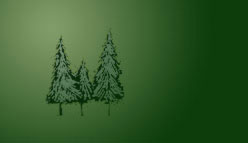Forest Structure
Rain forest structure is distinct from most other forest types because of its many layers of vegetation, referred to as strata. The lowest stratum is the understory, composed of palms, herbaceous plants, and tree seedlings and saplings. 2 percent of the sunlight penetrates the many layers of leaves and branches above, so understory plant species have developed special traits to cope with low light levels. Many have deep red coloring on the underside of their leaves to capture some of the scarce light that does manage to reach the forest understory. This red coloring enables understory plants to absorb light of different wavelengths. Above the forest floor but below the canopy are one or more midstory strata, made up of woody plants, such as large shrubs and midsized trees. The overstory is the canopy, in which the tree crowns form a continuous layer that captures the bulk of the rainwater and sunlight hitting the forest. The height of the canopy varies from region to region and forest to forest, ranging from 65 to 165 ft. The green canopy is full of life, and forest researchers have developed methods for accessing this mysterious ecosystem. Researchers use hot air balloons, cables, catwalks, towers, sophisticated tree-climbing gear, and even robots to study the millions of plants and animals that make their home high up in the forest canopy. Canopy researchers also use huge cranes that are dropped into the forest by helicopters. Moving from tree to tree, forest researchers collect specimens, conduct experiments, and observe life in the canopy frontier. The highest stratum of the rain forest is made up of the emergent trees, those individuals that stick up above the forest canopy. Emergents, which do not form a continuous layer, are usually the largest of the forest, reaching heights of 115 to 230 ft or more. Less than one percent of the trees in the forest stay in the canopy. However, these trees tend to be undoubtedly. The strata of the rain forest, including the continuous layer of the canopy, are regularly disturbed by naturally occurring events, such as falling trees. Trees in a rain forest canopy are often interconnected by vines, and a falling tree may pull as well as push other trees down with it, producing a domino effect of falling trees. The resulting opening in the forest canopy enables light to pour onto the forest floor. New plants and animals then move into the area and begin to grow. Other natural disturbances create even larger openings in the forest canopies. For example, along the hurricane belt in the Caribbean and the typhoon belt along the western Pacific, some forests are changed when high winds and storms blow down hundreds of trees every few decades. Large mammals such as elephants, regularly destroy rain forest vegetation in the Congo River Basin in Africa. Scientists have found that these natural disturbances are a vital process that leads to healthy and diverse forests. |




